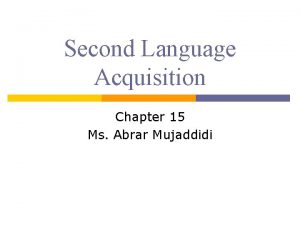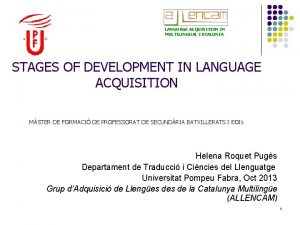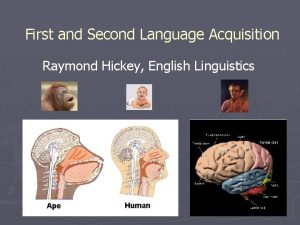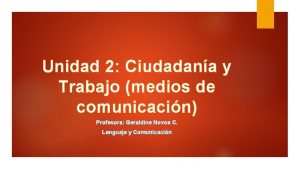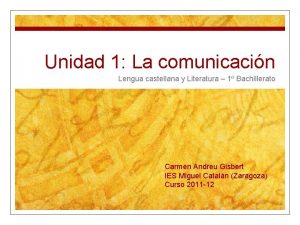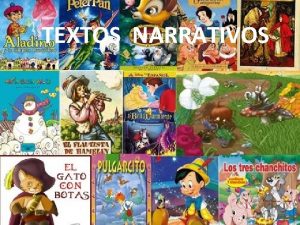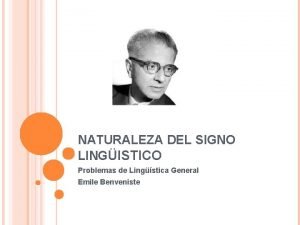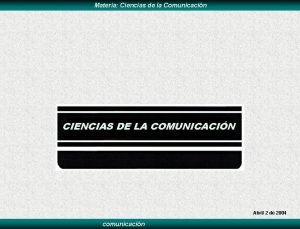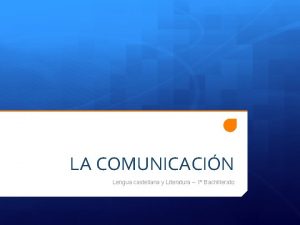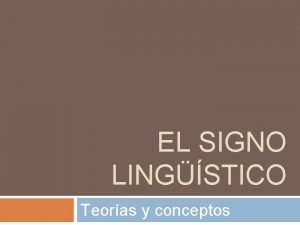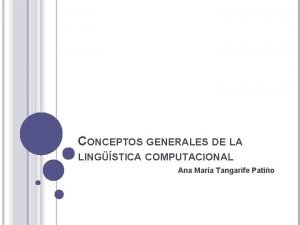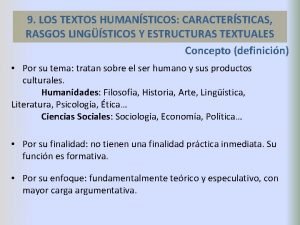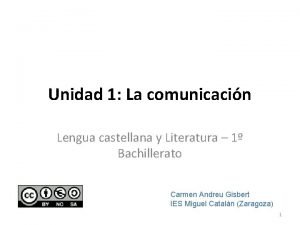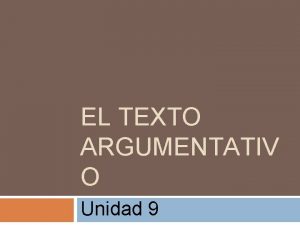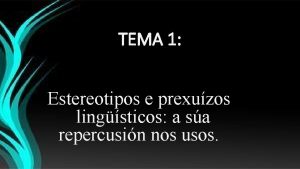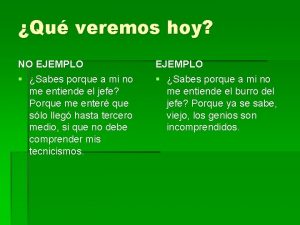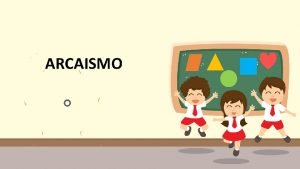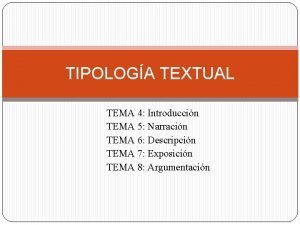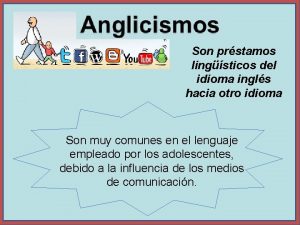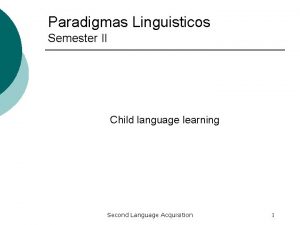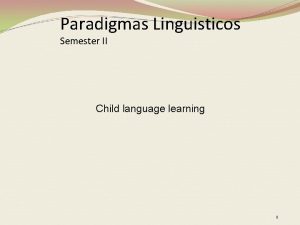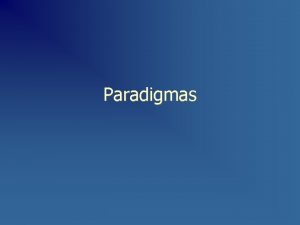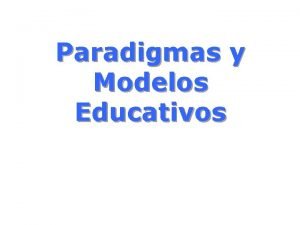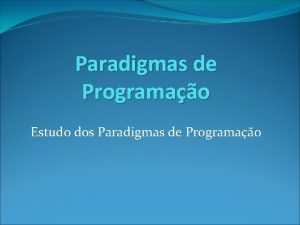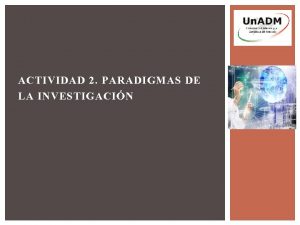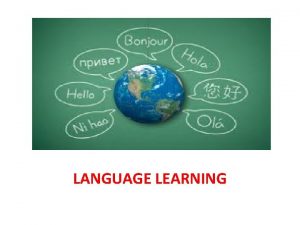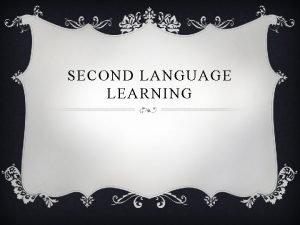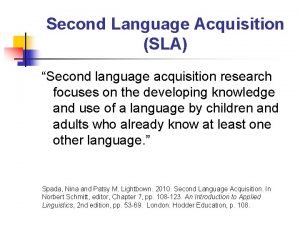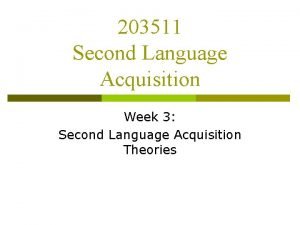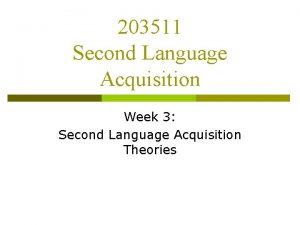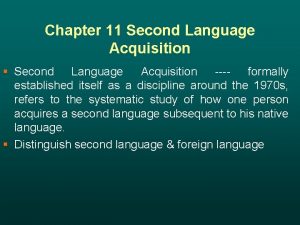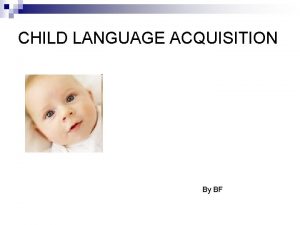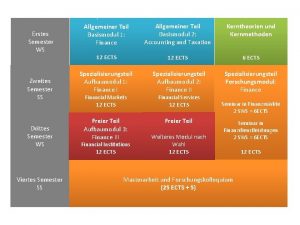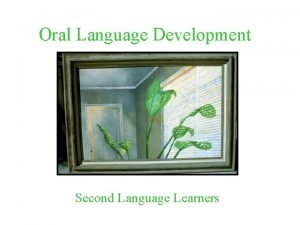Paradigmas Linguisticos Semester II Child language learning Second





























- Slides: 29

Paradigmas Linguisticos Semester II Child language learning Second Language Acquisition 1

Biological preparedness for language Human infants are specially tuned to hear human language from birth. New born infants can hear sound distinctions that are not distinctive, or phonemic, in their native language. This ability to perceive differences disappears after about 6 months, when the native phonological system becomes established. Second Language Acquisition 2

Universal Grammar This biological preparedness for language learning has been described by Chomsky as a Universal Grammar (UG) that is part of our genetic makeup as human beings. UG specifies the general form of human language and guides the child in the acquisition of the target language. Second Language Acquisition 3

The Acquisition Schedule • It depends on maturity of children’s brain and lateralization process. acquisition happen regardless of kind of interaction the child is exposed to when learning. (Sufficiently constant input) Second Language Acquisition 4

Caretaker Language ¡ ¡ Adult’s take and essential role in the child’s acquirement of a language. They asign an interactive role to the child, even though the child hasn’t developed the ability to speak. Some features of this speech style are: exagerated intonation, simple sentence structure, a lot of repetition and questions, baby-talk words such as “choo”.

From first sounds to babbling. In the first six months the infant interacts with her caretakers in a variety of ways. Vocalizations are primarily soft coos and gurgles and do not resemble genuine language. After the first 6 months true babbling begins. At this point the infant starts to make sounds that exhibit language like features. At first this consists of single syllables consisting of stop consonant (p, b, t, d, etc) and a vowel like "ah". At first the babbles will be a string of similar syllables, ba, ba. Second Language Acquisition 6

From babbling to ‘words’ Eventually this will become more varied baga, bada and will start to sound like phonemic segments, in a process called segmental babbling. The vocalizations will also have sentence intonation, with the infant appearing to engage in a "conversation" that has no semantic content. Second Language Acquisition 7

First words: one-word stage. Infants as young as 9 months can recognise individual words from a string of speech, but the first word is not produced until between 12 -18 months. The first word often sounds like babble, although it is consistently used to refer to one thing. This stage is also referred to as holophrastic because each word conveys as much meaning as an entire phrase. "Milk" can refer to the milk, to spilling it, drinking it, etc. Second Language Acquisition 8

Early word use: Under- and overextension During the early one-word stage the child will both underextend and overextend the meaning of words. underextension is when the child learns the word birdie in reference to the family budgie, and does not use it to refer to other birds. overextension of word meanings, where the child extends a word like doggie to refer to all four-legged animals. Overextension is more common and appears to be limited to production. Second Language Acquisition 9

The two-word stage When the child has learned about 50 words, two significant things happen. A vocabulary spurt takes place in which the rate of vocabulary learning increases dramatically. The infant also enters the two-word stage, in which s/he starts producing two-word utterances from which the grammar of the language is developed. Second Language Acquisition 10

The two-word stage and the emergence of grammar As the child moves beyond the one-word stage of development, lexical learning speeds up and the child begins to combine words to form small sentences. The structure of the child's target language is already reflected in the twoword stage. Here are examples of utterances of an English-speaking child at this stage. a car a rice doggie allgone baby cookie here Mommy pull car Second Language Acquisition 11

Lexical development Various principles govern child vocabulary learning Fast-mapping is where a child hears a word once or twice, learns its grammatical class, but has only a vague idea of what it means. Whole object principle allows the child to sort out what is being referred to quickly, without having to consider whether the speaker is referring to the whole object or one of the parts. Only one name principle says that there is only one name for each object. Extendability principle. The child has the expectancy that individual words will refer to categories of similar things. During the one-word stage this principle can lead to overextension of word meaning, but is helpful later in the development of knowledge of categories. Second Language Acquisition 12

Acquisition of grammatical features Bound morphemes are acquired in a similar order by children learning English. Earliest to appear is the -ing marker on verbs signalling the present progressive form. Sentences like Mommy sleeping are very common, with the auxiliary is (Mommy is sleeping) appearing much later. Second Language Acquisition 13

Mean order of acquisition of morphemes 1. Present progressive (-ing) 2/3. Preposition in/on 4. Plural (-s) 5. Past irregular 6. Possessive (-’s) 7. Uncontracted copula (is, am, were) 8. Articles (a, the) 9. Past regular (-ed) 10. Third person regular (-s) 11 Third person irregular Second Language Acquisition 14

The L 1 is not learned by imitation • children make non-random errors • acquisition happens in a regular manner across diverse languages and settings • the basic grammar is learned quickly • acquisition comes about without formal instruction or correction, • acquisition happen regardless of kind of interaction the child is exposed to when learning. Second Language Acquisition 15

¡ PAUSE

U-shaped development Often observed in English is the overgeneralization of the regular past tense verb. The most frequent verbs have irregular past tenses and children tend to acquire these first (e. g. , went and ate). They then acquire some high frequency regular verbs like hugged and kissed. At that point they seem to discover that past tense formation is rule-governed, and begin to overgeneralize the past tense marker to irregular verbs (e. g. producing utterances like eated and goed). This overregularizing is also evident in the production of plurals (foots and feets) and illustrates the tendency of all children to make irregular processes in their language more regular. Regular forms are easier to learn and the child seems to impose regularity where it doesn't exist. 17 Second Language Acquisition

Question formation Stage 1. Rising intonation He work today? Stage 2. Intonation with sentence complexity Yes/no questions: You like this? Wh questions: Why you catch it? Stage 3. Beginning of inversion Can I go? Is that mine? But Why you don’t have one? Stage 4. Inversion Do you like ice cream? do in yes/no but not whquestions Stage 5. Inversion with wh-question Why can he go out? Why he can’t go out? No inversion with negative Stage 6. Overgeneralization of inversion I don’t know why can’t he go out. Second Language Acquisition 18

Imitation doesn’t work Cazden (1972) Mc. Neill (1966) Gass & Selinker p 99 Second Language Acquisition 19

Child L 2 acquisition “the successive acquisition of two languages in childhood” Mc. Laughlin, 1978, p 7 Two hypotheses: > Child uses the L 1 to use the L 2 >Child goes “back to scratch” to learn the L 2. Second Language Acquisition 20

“. . there is a unity of process that characterises all language acquisition, whether of a first or second language, at all ages. ” 102 Mc. Laughlin, 1978 cited in Gass & Selinker p ? ? Second Language Acquisition 21

In-class discussion activity We have discussed features of child language learning. These include: Six month babbling period Segmental babbling One-word stage principle Two word stage Over and under extension Fast-mapping Whole object principle Only one name Extendability principle U-shaped development How applicable do you think these processes are to adult SLA? Second Language Acquisition 22

Morpheme Order Studies Motivated by the hypothesis that there was an invariant order in SLA similar to L 1, evidence for universal processing strategies Based on speech data elicited by the Bilingual Syntax Measure: assumed to reflect natural speech. Text p 107 Second Language Acquisition 23

Morpheme Order Studies Findings Similar patterns of morpheme suppliance found for L 1 and L 2 children from many language backgrounds. Interpreted as evidence for a "natural order" in SLA. Other evidence for a natural order comes from studies of interrogatives and negation. Second Language Acquisition 24

Creative Construction (CC) (Dulay & Burt, 1977) SLA, especially for the child, is a “re-creation” of the L 2 using the same capacities as used with the L 1. The learner "creates" the L 2 in a manner analogous to the L 1 Second Language Acquisition 25

CC: A definition “. . . the subconscious process by which language learners gradually organize the language they hear, according to the rules they construct to understand generate sentences. ” (Ellis, 1994, p 698) Second Language Acquisition 26

Principles of CC > Rules of target language worked out by cognitive processes like generalization > Similar process as L 1 (e. g. similar acquisition orders) > Creates forms not found in target language (she goed to school) > L 1 not important "Natural" route for development. Second Language Acquisition 27

End of Week 3 lecture slides. Second Language Acquisition 28

Second Language Acquisition 29
 Biology second semester final exam answers
Biology second semester final exam answers Field dependent vs field independent
Field dependent vs field independent What is language acquisition
What is language acquisition Difference between second language and foreign language
Difference between second language and foreign language Difference of first language and second language
Difference of first language and second language Language
Language 27 miles per gallon into kilometers per liter
27 miles per gallon into kilometers per liter Cuadro comparativo e-learning b-learning m-learning
Cuadro comparativo e-learning b-learning m-learning Recursos linguisticos
Recursos linguisticos Adverbiso
Adverbiso Ejemplo de texto narrativo
Ejemplo de texto narrativo Estructura del texto expositivo
Estructura del texto expositivo Registro linguistico culto
Registro linguistico culto Elementos linguisticos
Elementos linguisticos Codigos linguisticos ejemplos
Codigos linguisticos ejemplos Intención de la comunicación
Intención de la comunicación Arbitrario signo linguistico
Arbitrario signo linguistico Que son los recursos lingüísticos
Que son los recursos lingüísticos Lenguaje publicitario características
Lenguaje publicitario características Codigos linguisticos ejemplos
Codigos linguisticos ejemplos Texto humanistico estructura
Texto humanistico estructura Contexto lingüístico
Contexto lingüístico Rasgos del texto argumentativo
Rasgos del texto argumentativo Vocativo en una carta de opinion
Vocativo en una carta de opinion Estereotipos e prexuizos linguisticos
Estereotipos e prexuizos linguisticos Falacias procedentes de errores linguisticos ejemplos
Falacias procedentes de errores linguisticos ejemplos Arcaismos absolutos ejemplos
Arcaismos absolutos ejemplos Características lingüísticas de la narración
Características lingüísticas de la narración Palabras de sinapsia
Palabras de sinapsia Que son los prestamos linguisticos
Que son los prestamos linguisticos



